 |
FinescrollsawHistorical scroll saw fretwork catalogues |
|
Brief history of fretwork
1. AntiquityThe art of fretwork, as we recognize it today, has its origins in ancient craftsmanship, stretching back over 3,000 years. Early examples of decorative inlays that resemble fretwork can be found in Egyptian furniture designs, where intricate geometric patterns and motifs were often used to adorn wooden chests, chairs, and thrones. These inlays were typically created using thin strips of wood, ivory, or metals, set into the surface of the furniture to create highly detailed, ornate patterns. Similar decorative elements can be observed in the art of the ancient Greeks and Romans, where fretwork was used in the design of furniture, architectural details, and jewelry, reflecting the civilizations' emphasis on refined aesthetics and craftsmanship. |
2. The RenaissanceThe Renaissance period saw a surge in demand for elaborate woodworking, driven by aristocratic patronage and ornate interiors. In Germany, the tradition of detailed inlays was refined, while Italian craftsmen were known for colorful marquetry with geometric and floral patterns. Although the scroll saw did not exist in this period, craftsmen relied on fine hand saws, chisels, and compasses to create intricate designs, from wooden gears to decorative panels. The bow saw and other frame saws were sometimes used for more precise cuts. Clockmakers and cabinetmakers crafted detailed work that laid the foundation for modern fretwork. The Augsburg region, renowned for its fine craftsmanship, played a crucial role in advancing these techniques. Hans Holbein the Younger (1497–1543), renowned for his portraits, was also influential in the realm of decorative arts. His intricate designs for furniture and woodcarvings, especially those featured in his sketches, showcase detailed craftsmanship that aligns with the capabilities of early fret-saw techniques. While Holbein's primary legacy lies in painting, these designs demonstrate his awareness of the growing potential for precision tools in woodcraft. Some of these detailed woodwork patterns may have been realized using early forms of the fret saw, which allowed for finer, more intricate carving. |
3. The Baroque period. André-Charles Boulle: Innovator in Decorative Arts
The craft of fretwork advanced significantly in the late 17th century, thanks in large part to André-Charles Boulle (1642–1732), a Parisian master artisan famous for his work with intricate marquetry and inlaid designs. Boulle utilized a U-shaped tool, often referred to as the "Buhl saw," which is an early precursor to the modern fret saw or hand scroll saw. The U-shaped Buhl saw developed by Boulle was a refinement of existing tools, designed to achieve the precision required for his complex marquetry. Its curved frame allowed greater control over the delicate blades, enabling the intricate patterns that define his work. The Buhl saw represents a key milestone in the evolution of tools for fretwork. His innovations in ornamental design, decorative furniture and craftsmanship greatly influenced the development of fine woodworking tools. Boulle's artistic legacy is closely tied to the marquetry style named after him: Boulle style, renowned for its ornate patterns, including intricate scrolls, floral motifs, and arabesques. This technique involves the inlaying of contrasting materials such as tortoiseshell, brass, pewter, and exotic woods to create intricate patterns and images on furniture and decorative objects. His marquetry often contrasts light and dark materials to create dramatic visual effects. Influenced by Baroque grandeur, Boulle's designs frequently incorporate regal themes such as cherubs and mythological figures, along with symmetrical patterns and ornate architectural elements. His precision craftsmanship is evident in the detailed cutting and inlay work, elevating fretwork to an art form. 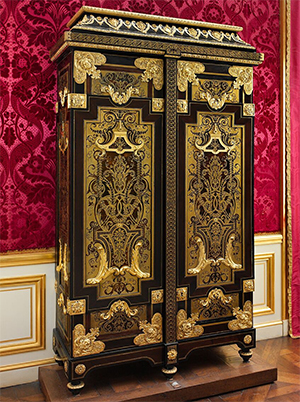
Appointed as "Ébéniste du Roi" (Cabinetmaker to the King) in 1672, Boulle created furniture and decorative pieces for Versailles and other royal residences. His fame extended beyond France, influencing cabinetmakers across Europe, who adopted and adapted his marquetry techniques. His innovative use of saws for intricate cutting helped spread the practice of fretwork. Boulle's work reached its zenith during the reign of Louis XIV, but his legacy endured well into the 18th century. Craftsmen in England, Germany, and Italy incorporated elements of the Boulle style, integrating fretwork into broader decorative traditions. Boulle’s contributions set the stage for the refinement of fretwork techniques and tools during the 18th and 19th centuries, influencing generations of craftsmen and helping transform fretwork into an enduring decorative art form. His legacy is preserved in museum collections worldwide, with many of his original pieces celebrated as masterpieces of Baroque design. |
4. The XIX century. The Mechanical Scroll SawAs the Renaissance and Baroque styles spread, so did the techniques associated with fretwork. Italy became a hub for artistic woodworking, incorporating fretwork into architectural panels and furniture. The craft also flourished in Flanders and England, where artisans adapted these techniques for local tastes. Italian craftsmen in Sorrento were especially renowned, and their methods spread to North America by the mid-1800s. 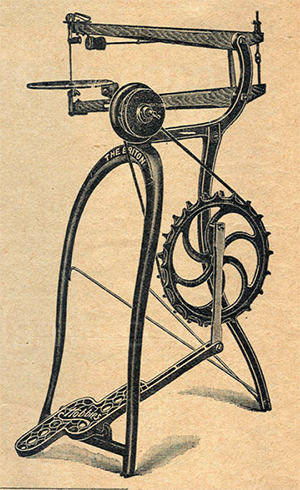
The earliest patent for a scroll saw was issued in Britain in 1829, and by the mid-19th century, mechanical fret saws powered by treadles—similar to sewing machines—emerged in the United States and Europe. The invention of the mechanical scroll saw was a result of the rapid technological advancements during the Industrial Revolution, a period marked by the development of machines designed to increase work efficiency. These new tools allowed artisans to create more intricate and complex designs with greater precision, reducing physical labor while increasing consistency. The introduction of these mechanical saws coincided with the Victorian era’s fascination with ornate, decorative patterns, helping to popularize fretwork as an art form. This era laid the foundation for the global popularity of scroll saw craftsmanship in the centuries to come. By the mid-19th century, treadle-driven saws had become increasingly common. In the UK, manufacturers like Heath & G. Smith, based in Sheffield, and Fulton & Co. were producing mechanical scroll saws among other tools. In the United States, companies such as Barnes Manufacturing Company and Millers Falls played key roles in popularizing treadle-powered scroll saws. These models were widely adopted by both professional craftsmen and hobbyists, significantly enhancing the precision and efficiency of woodworking and contributing to the growing popularity of mechanical saws during this period. Around 1870 pattern collections began to be published, often featured in magazines and catalogues, further fueling the craft’s popularity. |
5. 1880 - 1920. The golden era of scroll saw.By the late 19th century, fretwork had become a widely popular pastime in countries such as the UK, USA, Italy, France, and Germany, enjoyed both for artistic expression and as a source of supplementary income. Around the 1880s, scroll saw pattern collections began to emerge, and by the turn of the 20th century, these publications were offering some of the most refined and elegant designs ever conceived for the craft. The demand for these patterns soared, with sales reaching remarkable volumes, reflecting the widespread enthusiasm for this intricate and decorative woodworking art. For instance, on page 6 of the 1906 catalogue from the Italian collection ¨Il traforatore italiano¨, published by Pietro Barelli in Milan during the late 19th and early 20th centuries, it reads: "We always have the whole collection of patterns available, because the patterns are constantly reprinted. Many of these designs have reached 65 editions in a short time (65.000 copies). The number of patterns sold until december 1905 is 5.932.400". 
The artistic mind behind the collection ¨Il traforatore italiano¨ was Arturo Fumel. His designs are considered masterpieces of scroll saw artistry, showcasing unparalleled originality, elegance, and sophistication. These patterns often feature intricate, decorative elements that reflect a high level of craftsmanship and aesthetic refinement. While little specific biographical information about Fumel is available, his work has left a significant legacy in the field of scroll saw crafts, standing out as among the finest examples of Italian fretwork design. Unfortunately, many of the original patterns from this collection have been lost over time, making the surviving designs highly valued by collectors and enthusiasts today. Unfortunately, little is known about Arturo Fumel, and not even a photograph of him exists. Arturo Fumel was one of the sons of Pietro Fumel (1821–1886), an Italian general whose military career is well-documented, though details of his private life remain scarce. Pietro Fumel belonged to a family of aristocratic French origins, originally from the city of Fumel in the northeast of the Lot-et-Garonne department. The family sought refuge in Ivrea, Italy, after 1789 to escape the guillotine during the French Revolution. Pietro Fumel is particularly noted for his controversial role in the repression of brigandage in southern Italy following its unification. His leadership style, marked by severe measures, has been the subject of historical debate. Arturo's mother was Giuseppina Fumel (née Gomacchio). He had a half-brother, Vincenzo Sciamyl Fumel, who was born in Ivrea in 1857 and passed away on August 3, 1909. Vincenzo was the son of Pietro Fumel and Emilia Fumel (née Mazza). Vincenzo had a daughter, Pierina Maria Angiola De Benedetti (née Fumel) (1903–2000). Pierina is the mother of Franco De Benedetti (born 1933), an Italian business executive, entrepreneur, politician, and essayist, and Carlo De Benedetti (born 1934), an Italian industrialist, engineer, and publisher. Arturo Fumel is believed to have been born around 1850. He married and had a son, Cesare Fumel. In addition to being an accomplished artist skilled in drawing and ornamentation, Arturo was an avid photography enthusiast. Tragically, Arturo passed away prematurely on July 10, 1897, in Milan. I believe Cesare Fumel was the father of Arturo Fumel (1912–2001) (please contact me if you can confirm this), Virginia Giangrande (born Fumel), and another brother whose name is unknown. This Arturo married Anna Fumel (born Pettenati). Anna was born in 1913, and together they had two children. For this reason, I believe that Arturo Fumel may have descendants, most likely in Italy. Any additional information about his life or family would be greatly appreciated. If you have further details about Arturo Fumel, please feel free to get in touch. Established in 1895 by Fred T. Hodgson, the British magazine Hobbies initially focused on fretwork, offering weekly foldout patterns that catered to both practical and decorative crafting needs. These designs, ranging from household items to intricate decorative pieces, reflected the Arts and Crafts movement and Victorian influences. As the 20th century progressed and electric scroll saws emerged, the magazine began featuring patterns tailored for these innovative tools, further expanding its reach. Collectors today prize the foldout patterns published in the magazine, which stand as artifacts of the era’s enthusiasm for detailed craftsmanship. Hobbies Handicrafts, a major competitor to Hobbies Magazine, played a significant role in fostering creative pursuits during the 20th century. Focused on practical household crafts and decorative arts, it appealed to a readership interested in beautifying their homes and mastering various handcraft techniques. This publication not only offered a range of patterns and project ideas but also encouraged community engagement through reader-submitted letters and shared crafting experiences. Its emphasis on accessible crafts aligned with the broader Arts and Crafts movement, which celebrated handmade artistry and functional design The magazine distinguished itself by highlighting projects that balanced artistry with utility, often featuring designs rooted in Victorian and early 20th-century styles. As with Hobbies Magazine, the patterns and advice provided in Hobbies Handicrafts became cherished resources for artisans and hobbyists, cementing its place in the crafting culture of the era. These publications remain collectible today, serving as historical snapshots of the crafts and decorative styles of their time. In France, collections like Joubert-Tiersot became highly sought after, offering patterns renowned for their artistic quality. Published in Paris, these designs catered to both amateur and professional artisans, emphasizing ornamental and architectural elements. 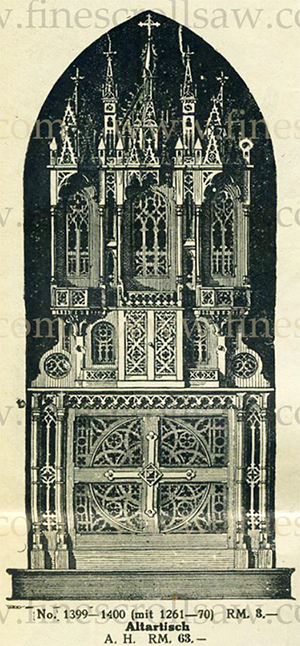
Germany's fretwork collections included the esteemed Mey & Widmayer patterns from Munich, which are often regarded as among the finest produced in Europe. The Limburgerhof collection, published in the late 1930s, brought together designs of varied origins, further enriching the German scroll saw tradition. These collections frequently reflected the Art Nouveau and Jugendstil movements, contributing to their widespread appeal. Similarly, in the United States, designers such as William J. Wild created extensive collections, later acquiring patterns from Bowman's and Russell's, consolidating them into a significant repository of American fretwork designs. These publications not only democratized access to scroll saw patterns but also reflected broader trends in leisure and craftsmanship, helping to sustain the popularity of scroll saw work. By encouraging readers to experiment with new tools and materials, they helped integrate the craft into both professional and recreational settings. The influence of these magazines extended well into the late 20th century, underpinning the enduring fascination with scroll saw craftsmanship. At that tine, patterns were glued to wood using a flour paste, which destroyed them during the cutting process, leaving few surviving examples. This scarcity makes finding original prints of these patterns nearly impossible today. Tragically, many of these masterfully designed works of artistic and ornamental craftsmanship are lost forever. You can explore these pattern collections and browse through several catalogues in the section dedicated to historical catalogues below. |
5. 1920-1950. The Advent of Electric Scroll Saws.The 1920s heralded a transformative era for scroll saw fretwork with the introduction of electric scroll saws, revolutionizing both accessibility and efficiency in the craft. Previously reliant on manually powered tools or treadle-operated saws, the new electric models eliminated the physical strain of operating the saw, making the process far easier and faster. This innovation democratized scroll saw work, enabling both professionals and hobbyists to explore the craft with greater freedom and precision. Delta Machinery, founded in 1919 by Herbert Tautz in Milwaukee, Wisconsin, became a key player in the scroll saw market. By the late 1920s, Delta introduced one of the first widely available electric scroll saws, which quickly gained traction among woodworkers in the United States. Their machines combined durability with user-friendly features, such as adjustable speeds and enhanced blade mechanisms, making them ideal for intricate fretwork. Delta's models were compact and designed for workshops, bridging the gap between industrial tools and home use. The success of Delta spurred competition, with other manufacturers entering the market. Companies like DeWalt and Craftsman also began producing electric scroll saws, further driving innovation and making the tools more affordable. The advent of the electric scroll saw in the mid-20th century marked a significant technological shift in the craft but surprisingly coincided with the decline of scroll sawing as a popular pastime. This trend is reflected in the changing focus of magazines from the era, which gradually moved away from featuring intricate scroll saw designs to other hobbies. By the 1930s, the artistic quality of published patterns had diminished noticeably. For instance, while magazines like Hobbies in 1915 still showcased elaborate and artistic fretwork designs, by 1930, the projects had become simpler, with fretwork relegated to a minor decorative role in practical items. This decline in artistic fretwork continued through the 1930s and 1940s, with fewer complex patterns being produced or published. |
6. 1950 to present. Scroll saw popularity Surge.In the 1940s and 1950s, electric scroll saws became more accessible, finding their way into home workshops amid the post-war economic boom and the rise of DIY hobbies. While this innovation made scroll sawing more efficient and accessible to enthusiasts, it failed to revive its popularity as a mainstream craft. Magazines and pattern catalogues of the era reflected this shift, with a notable decline in the publication of elaborate fretwork patterns. By the early 1950s, scroll sawing had largely transitioned to practical projects or disappeared from mainstream hobbies, remaining primarily in educational settings or niche woodworking circles. The craft's widespread heyday had passed, leaving it as a specialized interest rather than a household norm. The decline of scroll sawing as a widespread hobby in the 1950s and 1960s was driven by shifting trends and societal changes. Post-war hobbies like model building and electronics gained prominence, drawing interest away from traditional crafts. The demand for artistic fretwork diminished as woodworking projects became more practical and less decorative. Meanwhile, the rise of modern conveniences and changing lifestyles left less time for intricate, labor-intensive activities. Though electric scroll saws were introduced during this period, they failed to reignite widespread enthusiasm, primarily appealing to a small group of enthusiasts. Together, these factors relegated scroll sawing to near obscurity until its revival in the 1970s with the introduction of advanced and affordable models like Hegner among others. 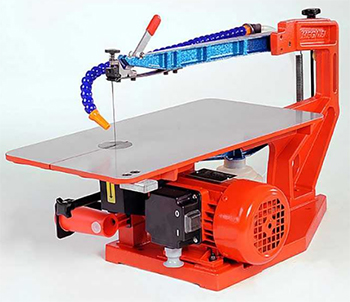
Hegner, founded in Germany in 1973 by Helmut Abel, quickly became a cornerstone of the scroll saw industry with its precision-engineered machines. Known for their smooth operation and precise cutting capabilities, Hegner saws, particularly the Hegner Multi-Cut and Multimax series, are recognized as some of the best in the world. These saws feature variable speed functionality, precise blade guidance, and vibration-free performance, making them ideal for handling intricate fretwork and a variety of other detailed projects. Hegner machines are celebrated for their stability, durability, and ability to cut through diverse materials, from wood and plastic to non-ferrous metals. The innovative designs, such as dual-tilt large tables and efficient sawdust management systems, ensure precision and comfort. With a reputation for longevity and minimal maintenance, Hegner has earned acclaim among both professional woodworkers and hobbyists worldwide, cementing its status as a trusted name in the scroll saw community. Delta Machinery, a prominent manufacturer based in the United States, has long been a leader in producing high-quality tools for both professionals and amateurs. They started producing electric scroll saws in the early 20th century and have continued to innovate, releasing newer models with advanced features like variable speed controls, vibration reduction, and tool-less blade changes. Their saws are known for durability and have become a trusted choice for many in the craft. Excalibur, another leading brand, is known for its Excalibur Scroll Saw series, which was designed to reduce vibration, improve accuracy, and provide greater control over intricate cuts. Since its introduction in the 1980s, Excalibur has built a solid reputation, particularly for its larger, professional models. Their saws are frequently used in both artistic and industrial applications, thanks to their precision and reliability. Axminster, a British company founded in 1972, has also contributed to the modern scroll saw revolution. While their models are often more affordable, they have worked hard to balance quality with accessibility, producing both entry-level and professional models. Axminster scroll saws are especially popular in the UK and Europe, where they offer a variety of saws that cater to both hobbyists and serious craftsmen. Pegas, a Swiss brand known for its precision, offers high-quality scroll saws made in Taiwan, praised for their stability and cutting accuracy. Seyco, renowned for its ST-21 model, specializes in precision saws with a unique swing blade tilt system, focusing on quality service, particularly in the U.S. market. King Canada produces reliable scroll saws suitable for both beginners and advanced woodworkers, while Carbatec offers durable, Australian-made options known for their solid build quality. Each brand is recognized for producing high-performance tools for various skill levels and applications. Fretwork, both a hobby and an art form, remains a dynamic and evolving practice in the modern world, with its origins tracing back to the use of simple hand saws and its transformation through mechanical and electric scroll saws. In recent decades, the craft has experienced a resurgence in popularity, appealing to a wide range of enthusiasts, from hobbyists in small home workshops to professional craftsmen creating intricate designs for high-end furniture and custom woodwork. This revival has been fueled by the development of advanced scroll saws that blend traditional techniques with modern innovations, improving both the efficiency and accessibility of fretwork. Today, the craft continues to thrive as both a beloved pastime and a respected art form, supported by ongoing advancements in scroll saw technology and the creativity of its practitioners. From traditional marquetry to contemporary abstract designs, fretwork enables artists to explore diverse styles. Thanks to the support of manufacturers and the global reach of online communities and educational platforms, fretwork remains a timeless and dynamic craft, likely to endure for generations to come. |
|
As a continuation of the historical introduction, I am sharing a collection of historic fretwork catalogues. My knowledge of the companies behind these publications is limited, so if you have any additional information, please feel free to reach out. Additionally, if you own any original patterns from these catalogues, I would be thrilled to hear from you. |
1. Pietro Barelli catalogues, Milan, Italy, 1906
|
Pietro Barelli founded his business in Corso Venezia, 15, Milan, Italy, in 1852. I know nothing about how he started but after some years his shop was a very well-known business dedicated to scroll saw, pirography, sculpture, painting, metalwork, leather work, magic, instructive games and other hobbies. After January 1878 he published a collection of scroll saw patterns called Il traforatore italiano (The Italian fretworker). The patterns in this collection were designed by Arturo Fumel, and were exported to different countries. Fretwork was an immensely popular hobby at the turn of the 20th century. Those years are considered the golden age of the craft, with patterns being produced and sold in remarkable quantities and quality, not only in Italy but across many Western countries. On page 6 of this brochure, it reads: "We always have the whole collection of patterns available, because the patterns are constantly reprinted. Many of these designs have reached 65 editions in a short time (65,000 copies). The number of patterns sold until december 1905 is 5,932,400". |
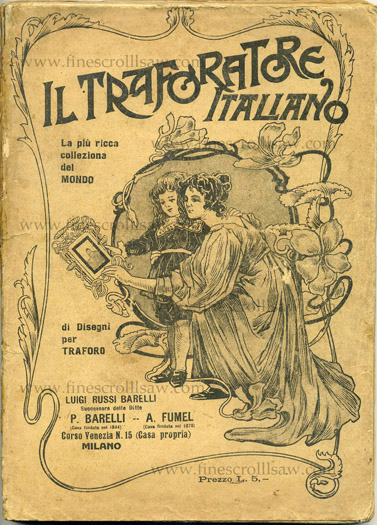 |
|
Over the years, Pietro Barelli published several catalogs showcasing the fretwork tools available in his shop and his extensive collection of fretwork patterns. Here, we present two brochures from 1906, with the second catalog serving as a continuation of the first. As you browse through these brochures, you'll see that words fall short in describing the sheer brilliance of these designs—they are truly breathtaking. Arturo Fumel’s boundless imagination, innovative spirit, and exceptional skill in ornamentation make him a consummate artist. Presently it is very difficult to find original patterns from this collection. I have been able to find only a small number of them, which are now restored and for sale in the section of patterns for sale. I am afraid most of them are lost for ever. If you own some please contact me. Also contact me if you can provide more information about Pietro Barelli or Arturo Fumel, the shop, how and when it came to and end, etc, any information about this will be appreciated. The first catalogue includes the first part of the collection and the second catalogue includes the second part of the collection. Click here to download the first catalogue in PDF format and click here to download the second catalogue in PDF format. |
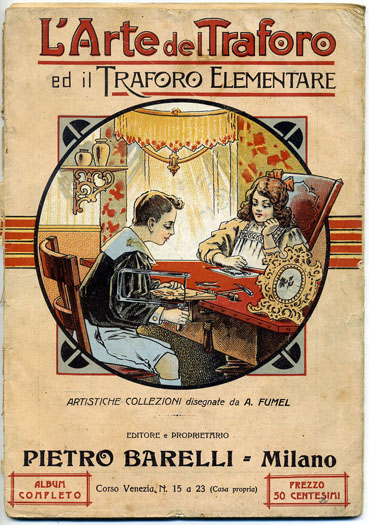 |
2. Hobbies fretwork catalogue, England, 1912
|
In October 1895, Hobbies published the first issue of its weekly magazine, primarily dedicated to fretwork, though it also featured articles on a wide variety of hobbies, such as stamp collecting, ironwork, magic, cycling, football, and more. Each issue included a foldout sheet with a fretwork pattern. Over time, the patterns in Hobbies grew in both originality and quality. The magazine also released several catalogs showcasing a comprehensive selection of fretwork tools and their finest patterns. The catalog we present here is from 1912, a time when Hobbies boasted an impressive range of fretwork designs, including clocks, coffers, shelves, and many other decorative items—many of which are considered masterpieces of design. The style of these patterns is elegant, sober, and understated. Some of the designs are reminiscent of the Arts and Crafts movement, while others clearly reflect the influence of Indian decoration, a hallmark of the Victorian period. At the beginning of the 20th century, fretwork was an immensely popular hobby in England, which led Hobbies magazine to sell vast numbers of copies—certainly hundreds of thousands, possibly even millions. These patterns have been better preserved than those from other countries, allowing us today to offer many of them, with occasional new discoveries. If you happen to have any of these patterns, I would love to hear from you. You can contact me at [email protected] |
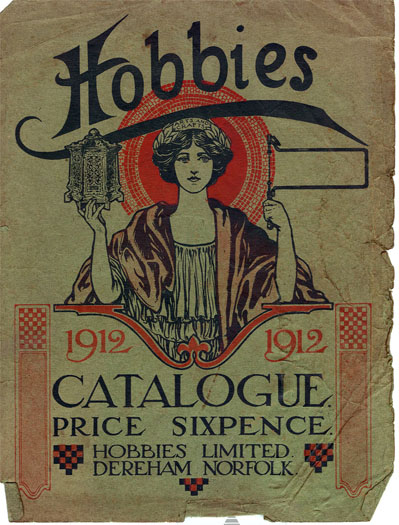 |
3. Bowman's (c. 1880), Russell's (c. 1880) and Wild's (1893) scroll saw patterns catalogues, USA.
|
William J. Wild is one of the best-known scroll saw designers in the USA. He founded his business in New York in 1876 and created some of the most remarkable scroll saw designs in the country. Later, Wild acquired the designs of two other scroll saw companies—Bowman’s and Russell’s—forming the most impressive collection of scroll saw patterns for sale in the USA at the time. Here, we present catalogues from Bowman’s, Russell’s, and Wild’s businesses when they were still independent, around 1880. Some of these designs are of exceptional artistic quality, elegant, well-proportioned, and evocative. |
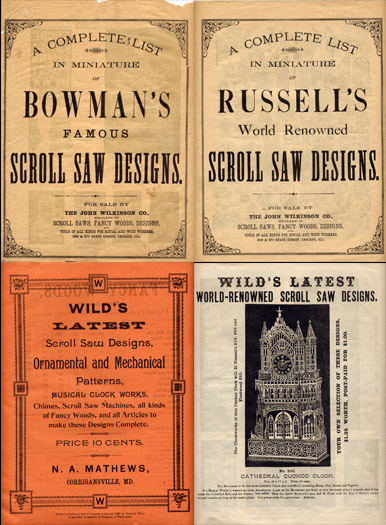 |
4. Amati's scroll saw patterns catalogue, Torino, Italy, c. 1920.
|
Carlo Amati founded his scroll saw and fretwork patterns company in Turin, Italy, in 1879. Over time, his collection of designs grew into one of the largest in Europe. This particular catalogue, dating from around 1920, contains the entire collection of patterns his company offered for sale at that time. While these designs may not match the unparalleled artistic quality of those produced by Arturo Fumel for Pietro Barelli, many come remarkably close in terms of originality and beauty. The preface to the catalogue reads (translated from Italian): "Scroll saw art is already 72 years old and continues to be appreciated and chosen by lovers of beauty. It is also valued today as the best pastime, for it combines pleasure, elegance and ease. On hot summer days, and in the long winter evenings, scroll saw provides a special satisfaction, more than any other hobby. So the soldier in the barracks, the sailor on board the ship, the religious in the monastery and the family in the city, they all find in scroll saw the way to spend their leisure time with pleasure. And all this appreciation for the art of fretwork is evidenced by the increasing growth of my business. The worldwide faithful and devoted clientele have me fully convinced that the treatment given so far to my respected clients, which are the same that make good publicity to my business, is such that if we keep it, we will always have their best confidence and consideration. Exporting proves that my designs are well received abroad. It will always be my concern to work to maintain L'Arte del traforo torinese the richest and most elegant magazine in its genre. The reward is the clientele acquired without much need for ads, proof that my business is able to serve all orders with both product quality and in due time". |
 |
5. Ettore Ferrari's fretwork patterns catalogue, Milano, Italy, 1934.
|
This collection of patterns was initiated around 1865 in Milan, Italy. The collection underwent several name changes as the company changed ownership over the years. In 1897, it was under the management of A. Nava C., and the collection was named Il nuovo traforatore Italiano (The New Italian Fretworker). Shortly after the turn of the 20th century, the collection came under Ettore Ferrari's company, and it was rebranded as Il nuovo traforatore artistico (The New Artistic Fretworker). The patterns in this collection are remarkable for their sophistication and refinement. The stunning designs, along with the subtle use of elegant shapes and proportions, clearly demonstrate that the designers were masters of the 19th-century ornamentation techniques. |
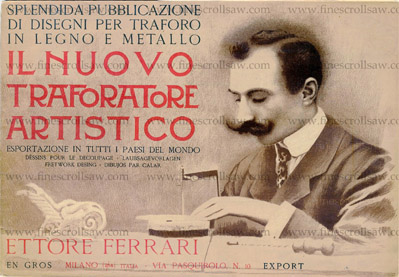 |
6. Joubert-Tiersot fretwork patterns catalogue, Paris, France, 1924.
|
This series of fretwork designs was established in 1865 by A. Tiersot. The name was later changed to Joubert-Tiersot. The company's offices were located at 35, Avenue de la République in Paris, and the patterns were sold by E. Jacquot at 30, rue Turbigo, also in Paris. The collection grew to become the most prestigious in France, featuring a wide array of highly artistic designs. The catalogue presented here is the 15th edition, and dates back to 1924. This catalogue includes most of the patterns that appeared under this firm. |
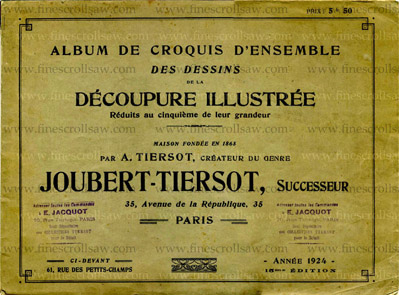 |
7. Hofmann & Schmitt fretwork patterns catalogue, Limburgerhof, Germany, c. 1938.
|
This collection of patterns was published in Limburgerhof, Germany, around 1938. The variety of styles is immediately apparent, as the collection appears to feature patterns from various origins. Among these are the designs from the renowned old German collection of Mey & Widmayer in Munich, which are undoubtedly the most beautiful fretwork patterns ever created in Germany. Many of the patterns in this collection exhibit exceptional artistic quality, especially those from the 19th century. However, some designs raise questions of taste, such as the lamps adorned with portraits of Nazi leaders. |
 |
8. J. N. Jacques fretwork catalogue, Liège, Belgium, 1924
|
The firm J. N. Jacques was founded at the end of the 19th century and was based at 35 rue Souverain Pont, Liège, Belgium. They offered everything needed for the scroll saw hobby, including an extensive selection of woods and patterns. This 1924 catalogue showcases the impressive collection of fretwork patterns available for sale at that time. |
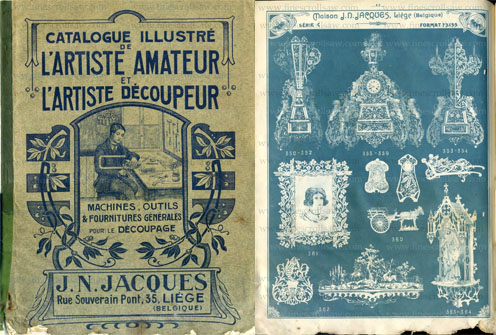 |
9. L. Chonet fretwork catalogue, Brioude, France, c. 1920
|
The firm L. Chonet was established in 1862 in Brioude (Haute-Loire), France. It offered everything necessary for the fretwork in wood and metal. This is the sixth edition of their catalogue of patterns. |
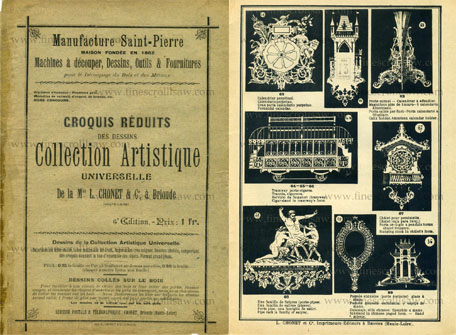 |
10. Hobbies fretworkers' weekly, special coronation number, may 20th 1911
|
Started in 1895 ¨Hobbies, the fretworkers' weekly¨ soon became one of the most widely distributed crafts magazines in the UK. The magazine presented articles on different crafts and leisure time topics, but was mainly focused in fretwork. Between 1895 and well into the XX century Hobbies published weekly some of the most beautiful scroll saw fretwork patterns ever conceived. These designs were not so wildly ornamented as the Italian ones, but they were always very elegant and appealing. On may 20th 1911 Hobbies issued a special number on the occasion of the coronation of king George V. As a historical curiosity I am publishing here this number entirely, including all articles, even those not related to fretwork, the special coronation postcard and the two scroll saw patterns it contained as foldouts. The patterns are definitely not among the best of Hobbies, but they are still interesting and you can use them to practice and improve your skills. These patterns are offered as they were published, scanned and without any kind of restoration. |
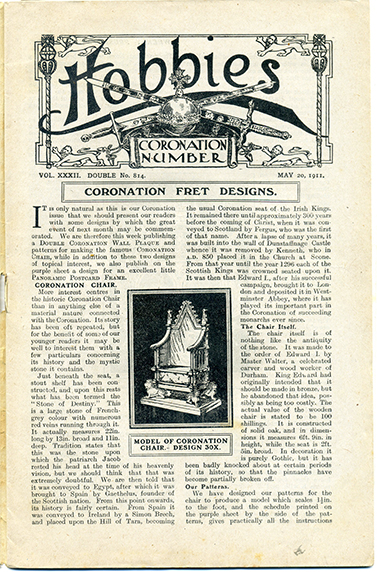 |
|
© Copyright 2024 Pedro López Rodríguez. All rights reserved. |